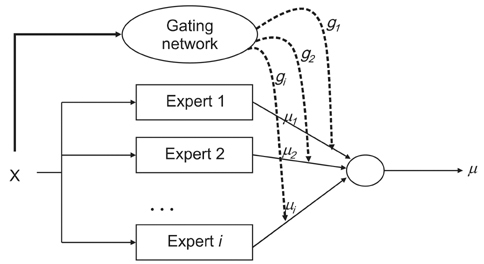Healthc Inform Res.
2013 Jun;19(2):130-136. 10.4258/hir.2013.19.2.130.
Modified Mixture of Experts for the Diagnosis of Perfusion Magnetic Resonance Imaging Measures in Locally Rectal Cancer Patients
- Affiliations
-
- 1Department of Medical Information and Administration, College of Health Science, Jungwon University, Goesan, Korea. smmyoung@jwu.ac.kr
- KMID: 2229494
- DOI: http://doi.org/10.4258/hir.2013.19.2.130
Abstract
OBJECTIVES
This study demonstrates the feasibility of using a modified mixture of experts (ME) model with repeated measured tumoural Ktrans value to perform an automatic diagnosis of responder based on perfusion magnetic resonance imaging (MRI) of rectal cancer.
METHODS
The data used in this study was obtained from 39 patients with primary rectal carcinoma who were scheduled for preoperative chemoradiotherapy. The modified ME model is a joint modeling of the ME model via the linear mixed effect model. First, we considered two local experts and a gating network, and the modified expert network as a liner mixed effect model. Afterward, the finding estimates were obtained via the expectation-maximization algorithm. All computation was performed by R-2.15.2.
RESULTS
We found that two experts have different patterns. The feature of expert 1 (n = 10) had a higher baseline value and a lower slope than expert 2 (n = 29). A comparison of the estimated experts and responder/non-responder groups according to T-downstaging criteria showed that expert 1 had a more effect treatment responder than expert 2.
CONCLUSIONS
A novel feature of this study is that it is an extension of classical ME models in case of repeatedly measured data. The proposed model has the advantages of flexibility and adaptability for identifying distinct subgroups with various time patterns, and it can be applied to biomedical data which is measured repeatedly, such as time-course microarray data or cohort data. This method can assist physicians as important diagnostic decision making mechanism.
Keyword
MeSH Terms
Figure
Reference
-
1. Corchado JM, De Paz JF, Rodriguez S, Bajo J. Model of experts for decision support in the diagnosis of leukemia patients. Artif Intell Med. 2009; 46(3):179–200.
Article2. Shortliffe EH, Cimino JJ. Biomedical informatics: computer applications in health care and biomedicine. 3rd ed. New York (NY): Springer;2006.3. Spilker ME, Seng KY, Yao AA, Daldrup-Link HE, Shames DM, Brasch RC, et al. Mixture model approach to tumor classification based on pharmacokinetic measures of tumor permeability. J Magn Reson Imaging. 2005; 22(4):549–558.
Article4. Jacobs RA, Jordan MI, Nowlan SJ, Hinton GE. Adaptive mixtures of local experts. Neural Comput. 1991; 3(1):79–87.
Article5. Jordan MI, Jacobs RA. Hierarchical mixtures of experts and the EM algorithm. Neural Comput. 1994; 6(2):181–214.
Article6. Chen K, Xu L, Chi H. Improved learning algorithms for mixture of experts in multiclass classification. Neural Netw. 1999; 12(9):1229–1252.
Article7. Dempster AP, Laird NM, Rubin DB. Maximum likelihood from incomplete data via the EM algorithm. J R Stat Soc Series B Stat Methodol. 1977; 39(1):1–38.8. Ubeyli ED. A mixture of experts network structure for breast cancer diagnosis. J Med Syst. 2005; 29(5):569–579.
Article9. Subasi A. EEG signal classification using wavelet feature extraction and a mixture of expert model. Expert Syst Appl. 2007; 32(4):1084–1093.
Article10. Raman S, Fuchs TJ, Wild PJ, Dahl E, Buhmann JM, Roth V. Infinite mixture-of-experts model for sparse survival regression with application to breast cancer. BMC Bioinformatics. 2010; 11:Suppl 8. S8.
Article11. Myoung S, Chang JH, Song K. A mixture of experts model for the diagnosis of liver cirrhosis by measuring the liver stiffness. Healthc Inform Res. 2012; 18(1):29–34.
Article12. Shankaracharya , Odedra D, Samanta S, Vidyarthi AS. Computational intelligence-based diagnosis tool for the detection of prediabetes and type 2 diabetes in India. Rev Diabet Stud. 2012; 9(1):55–62.
Article13. Lim JS, Kim D, Baek SE, Myoung S, Choi J, Shin SJ, et al. Perfusion MRI for the prediction of treatment response after preoperative chemoradiotherapy in locally advanced rectal cancer. Eur Radiol. 2012; 22(8):1693–1700.
Article14. Padhani AR, Liu G, Koh DM, Chenevert TL, Thoeny HC, Takahara T, et al. Diffusion-weighted magnetic resonance imaging as a cancer biomarker: consensus and recommendations. Neoplasia. 2009; 11(2):102–125.
Article15. McCullagh P, Nelder JA. Generalized linear models. New York (NY): Chapman and Hall;1983.16. Jordan MI, Xu L. Convergence results for the EM approach to mixture of experts architectures. Neural Netw. 1995; 8(9):1409–1431.
Article
- Full Text Links
- Actions
-
Cited
- CITED
-
- Close
- Share
- Similar articles
-
- Imaging Diagnosis of Colorectal Cancer
- Imaging Diagnosis of Locally Advanced Rectal Cancer: Tumor Staging before and after Preoperative Chemoradiotherapy
- Radiologic Report for Magnetic Resonance Imaging of Rectal Cancer before Treatment
- Clinical Significance of Preoperative Magnetic Resonance Imaging in Staging of Rectal Cancer
- Recent Progress in Diagnosis and Treatment of Rectal Cancer






